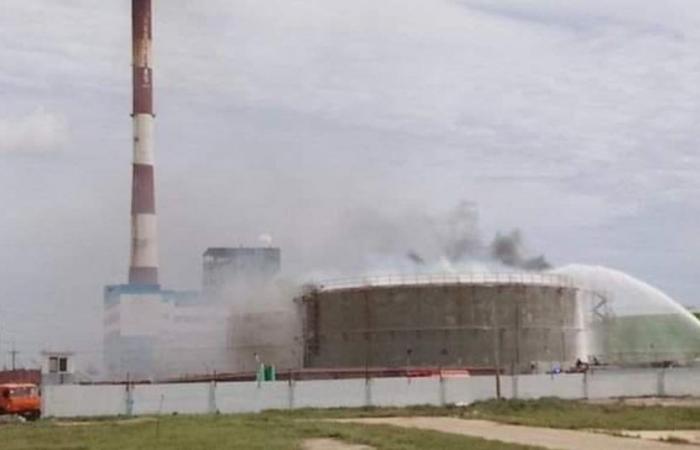Madrid/One of the fuel tanks that feed the Antonio Guiteras thermoelectric plant in Matanzas, the most important in the country by generating capacity, is on fire this Friday. According to Radio 26 on its social networks, the fire “may have been the result of maintenance work that was being carried out in the area.” Although it is located within the plant grounds, authorities were quick to clarify that it “remains online,” generating 260 megawatts (MW).
Rubén Campos Olmos, director of Guiteras, told national television that they are investigating the causes and that “a repair process was underway on the ladder of that tank” when “the fire occurred.” Given how volatile the national crude oil is, the official explained, “any situation can ignite this fuel.” The Minister of Energy and Mines, Vicente de la O Levy, also went to the place.
The local station detailed that the tank, “of lower capacity than those that caught fire during the incident at the Supertanqueros base” (in August 2022), was “practically full.” The differences, in fact, are notable: the capacity of the Guiteras tankers is 10,000 cubic meters, while the Supertankers were 50,000 cubic meters. In the commentary of the official media, however, the concern of the population is evident, who two years ago saw how the most important crude oil storage center on the Island was destroyed, also in Matanzas, in the most serious industrial fire of the island. history of Cuba. That incident, whose specific causes are still unclear, cost the lives of 17 people, almost all of them firefighters.
An hour after reporting on the extinguishing work, no fire was visible but the damage suffered by the tank was visible.
The first secretary of the Communist Party in the province, Mario Sabines Lorenzo, declared to Radio Rebelde journalist José Miguel Solís that “no human damage has been reported and the possible areas of fire spread to similar warehouses located in the vicinity of the unit are being fought. generator.”
In the images shared by Radio 26, a thick column of black smoke was observed in the morning hours, typical of burning oil. An hour after reporting on the extinguishing work, no fire was visible but the damage suffered by the tank was visible.
The incident occurs at a time that is once again critical for electricity generation on the Island. This Thursday, the deficit once again exceeded the three-digit barrier, with 1,240 MW, and the Electrical Union’s forecast for this Friday does not improves too much (a deficit of 902 MW and an impact of 972 MW during peak demand hours).
With eight units out of service due to breakdown, maintenance or lack of fuel (in the CTE Mariel, Santa Cruz, Renté, Felton, Nuevitas and Cienfuegos), Cuba cannot allow the Guiteras to leave the National Electric System.
The ‘Vilma’ is returning to the Island after loading some 400,000 barrels of crude oil in the Mexican port of Pajaritos
Although Cuban plants use national crude oil, the oil that continues to arrive from Venezuela, Mexico or Russia is vital for the Island and serves to power generators, transportation and industry. Precisely, this Friday, after months of being off, the torch of the Ñico López refinery in Havana was turned on again, indicating an increase in its activities to treat imported crude oil.
Sources of 14ymedio indicated that Venezuela used the ships Athens and the Tina 5 to transport a part of the 70,000 barrels per day (bpd) of crude oil that Caracas sent to the Island last month. The movements of the ships were not detected by maritime tracking applications because they disconnected their transponders to avoid radars and “transferred their cargo to smaller vessels in Nipe Bay, in the province of Holguín, or in Matanzas,” says an expert who closely follows oil shipments to Cuba.
For his part, the specialist from the University of Texas Jorge Piñón indicates to 14ymedio that the tanker Vilma It is returning to the Island after loading some 400,000 barrels of crude oil in the Mexican port of Pajaritos (state of Veracruz). However, it is not known specifically which port it will arrive at. “It seems that his destination is Cienfuegos. I doubt it is Santiago. We will have to wait a couple more days,” warns the expert.
Russia and Cuba spoke about the joint project of the Boca de Jaruco field, “where high levels of crude oil extraction were reached”
Meanwhile, still visiting Moscow, the Cuban Deputy Prime Minister, Ricardo Cabrisas, has obtained from the Russian Minister of Energy, Sergei Tsiviliov, a promise to help the Island generate electricity. “The construction of new energy facilities is an important stage in restoring the working capacity of Cuba’s energy system,” said the Russian minister, quoted on Telegram. “I am sure that the participation and experience of Russian specialists will represent a considerable contribution to the energy branch of the republic.”
According to the Russian Ministry of Energy, representatives of Russia and Cuba “discussed the prospects for cooperation” in the field of fuel and energy, as well as in the construction of facilities on the Island.
They also discussed cooperation in the field of oil and gas, in particular around the joint project of the Boca de Jaruco field, “where high levels of crude oil extraction were reached.” “The exchange of professional experiences will foster the development of dialogue between our countries on energy matters,” Tsiviliev stressed.






